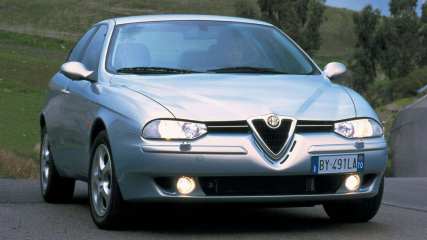Alfa Romeo 156 2001 Review
By Paul Gover · 30 Mar 2001
From its basic ingredients to the last bit of garnish, Alfa's baby wagon passes the taste test. In a world of bland vehicles, it's good to find something with taste.Many carmakers try to add the flavour last with a sprinkle of herbs and spices, but Alfa Romeo has always had more than just a basic recipe. Its cars have taste all the way through, from their sweet-sounding engines to the seats and switches.And the latest generation is better than cars of the past because the new models pass the taste test without sacrificing quality, reliability and value. Which brings us to the Alfa 156 Sportwagon. It's a baby wagon built on the back of the most impressive new Italian car in more than 10 years. No, make that 15 years.The 156 sedan is a tidy little thing that has done a great job, together with the GTV and Spyder, in getting Alfa back on Aussie shopping lists. The Sportwagon moves things a fair way down the road but, as the name says, it's not a full-on family hauler.The multi-purpose Alfa is designed for people who like to drive and need to carry a youngster or two, but more likely want some flexibility in their weekend motoring. Holden and Ford utes do a similar job. The good thing about the Alfa is that it has so many clever tweaks. The basics are good, including the comfy seats and its 114kW four-cylinder engine, but the tail tweak has been done to provide a high-opening rear door with great access.Inside, there is a reversible rubber-lined carpet, tie-down hooks, a cargo net, split-fold seats, a ski port for long loads, mesh carry-pocket and even reflectors for night safety. The 156 is a mid-sized car, similar to the Holden Vectra, with front-wheel drive and a choice of a five-speed manual gearbox or the hi-tech Selespeed automatic. It also has fully independent suspension, anti-skid four-wheel discs, power steering with great feel, and plenty of standard equipment.It has four airbags, alloy wheels, auto aircon, CD sound and even a 12-volt power socket. There are plenty of rivals for the Sportwagon, from the cheaper and more family-focused Subaru Liberty to the costlier and better-known Audi A4 Avant wagon. The Sportwagon opens at less than $50,000, which is pretty good value today.DRIVINGFrom the first touch it's obvious that the Sportwagon is a bit different. It's the old-fashioned chromed doorhandles that send the first message. It's the same inside, where the tasty stuff runs from the optional leather seats and great-looking instruments to the feel of the switches and the layout of the controls.The wagon end isn't big, but it will do a lot of jobs and has plenty of flexibility - the real key to a working-class contender. It's not big and boxy like a Volvo or Liberty, and even tails the A4, but it would be the right size for young families and OK for people with dogs and water toys. The shape of the Sportwagon also takes it away from family land. It has a good-looking sweep back from the doors.The car gets along nicely. The torquey four boogies (like all Alfa engines) if you give it a kick. It sounds great, which has always been part of Alfa's appeal, though the temptation to push along can hurt fuel economy. The five-speed manual in the test car worked well, with a good ratio spread and the right gears for overtaking, without some of the quirkiness that has other testers avoiding the Selespeed system.The Alfa handles well, with good balance loaded and unloaded, though the ride is less convincing. The tail jumps around a bit with nothing on board and sags too much with a load - not a big problem, but worth thinking about. The Sportwagon is light to handle and easy to park, has fair headlights and a bold horn, and promises few worries for owners. The 156 is more costly than the Liberty, which is a top-class car and a family bargain, but lines up well on price and features against its better-known Euro opposition. It has a unique taste and flair that makes it worth a look for anyone who needs a wagon, but doesn't want to drop straight into suburbia.ALFA ROMEO 156 SPORTWAGONPrice: $48,500 (price as tested)Engine: 2.0-litre four-cylinder with double overhead camshafts and fuel injectionPower: 114kW at 6400 revsTorque: 187Nm at 3500 revsTransmission: Five-speed manual, front-wheel driveBody: Five-door wagonDimensions: length: 4430mm, width: 1745mm, height: 1420mm, wheelbase: 2595mm, tracks: 1511mm/1498mm front/rearWeight: 1300kgFuel tank: 63 litresFuel consumption: test average 11.4 litres per 100kmSuspension: Power-assisted rack and pinion. Fully independent with double-wishbone front and rear struts with anti-roll barsBrakes: Anti-skid four-wheel discsWheels: 6.5x15 alloysTyres: 205/60 R15Warranty: 3-years/100,000kmRIVALSAudi A4 Avant from $58,600Subaru Liberty from $31,800Volvo V70 from $55,950







